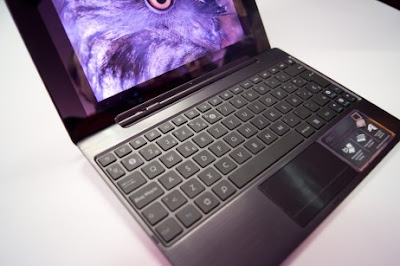This week Texas Instruments has announced the first big collaboration with OMAP 5, their next-level processor and in their newest technologies for a multi-core experience that brings their products to the forefront not just for the excellence of their products themselves, but because the Texas Instruments OMAP 5 platform has proven itself capable of handling their robots and in-vehicle systems the best. The new OMAP 5 system-on-chip was revealed at the Consumer Electronics Show in January but TI has brought it back to MWC to let everyone in on a few more details and there's the latest PowerVR graphics processing (GPU) technology with a dual core SGX544 GPU to churn out flashy apps, multimedia and games, while a dedicated 2D hardware accelerated engine handles your run-of-the-mill stuff seamlessly and without touching memory outside the chip itself, this gives a smoother overall experience and more power efficiency.
 Texas Instruments Incorporated
Texas Instruments Incorporated (TI) turned the spotlight on the
OMAP 5 platform, illustrating through live demonstrations the unprecedented performance capabilities of the highly anticipated addition to the OMAP processor family. Poised to service smartphones and numerous other markets-from automotive to smart home-the
OMAP 5 platform uniquely enables leading digital hubs to deliver premium content while consumers capture, edit, store and share their own content across numerous end equipments. The result is a multimedia-rich, multitasking-intense visual experience without compromise. TI's
OMAP platform has long harnessed a balanced system identified as the smart multicore architecture to deliver the highest applications processing performance at the lowest possible power. The evolution of this architecture, that today comprises the
OMAP 5 platform, changes what's possible in mobile computing, and delivers a superior user experience leveraging TI's mobile-optimized 28nm process. Mobile applications benefit from the distribution of interdependent activities across multiple processors to create fluid performance and fast responsiveness. However, in reality most of these applications today are single-threaded or have a dominant single-threaded task or process, and are thereby unable to partition across large numbers of CPU cores within a platform. In light of this market reality, the
OMAP5430 processor includes two
ARM Cortex-A15 cores that provide the highest single-thread performance of any ARM CPU. Unique to the OMAP 5 smart multicore architecture is the use of two ARM Cortex-M4 cores to complement the two
ARM Cortex-A15 cores. The M-class cores are appropriately assigned real-time control processing of multimedia tasks, like video encoding and decoding, freeing the main CPU cores to manage high level operating system tasks. In addition to minimizing the Cortex-A15 cores' interrupt rate, this off-loading function delivers an invaluable power savings-as much as 10 percent of the system power when encoding and decoding high definition
H.264 content, for example.
In a market driven largely by graphics performance, the ability to raise the bar without increasing power consumption is a competitive advantage benefitting any application's performance. The
OMAP 5 platform represents several upgrades to preceding OMAP processor families, including the introduction of a second GPU. Through the use of dual-core
PowerVR SGX544 GPUs from Imagination Technologies, the OMAP5430 processor outperforms the competition by up to 4x across common industry graphics benchmarks. Imagination Technologies differentiates its SGX544 cores through the use of a tile-based deferred rendering architecture, which reduces bandwidth usage and minimizes power consumption when compared to competitive solutions. TI harnesses this unprecedented graphics performance by complementing the GPUs with unique
OMAP platform capabilities while running the cores at their maximum limit of 532Mhz.
"The long term partnership between Imagination and TI has resulted in many market-defining firsts. With the OMAP 5 platform, the application of dual-core, industry-leading PowerVR GPUs running at their top performance is sure to create exceptional user experiences that stand at the forefront of graphics performance," said Hossein Yassaie, CEO, Imagination Technologies. The SGX544 cores are augmented by still another unique
OMAP architecture feature-a dedicated 2D hardware-accelerated composition engine – which can support up to 8 layers of high resolution composition without the need to go to external memory. The smart multicore system off-loads compositing to the composition engine, lowering power consumption by as much as 10x what the GPU would expend running the same eight layer composition process. This is done without passing data back to the memory, freeing the memory bandwidth for other multitasking functions. Mobile platforms are constrained to a fixed thermal budget – otherwise a device might feel too hot in a user's hand. If the processor exceeds this budget, it must be throttled. This is a process that can limit the real performance of the device. Expertly navigating this challenge to yield the ultimate performance within the mobile thermal budget, the
OMAP 5 platform balances the right performance to deliver under this thermal constraint the highest possible effective MIPS, reaching upwards of 35 percent greater than the latest quad-core market solutions. Under a realistic thermal budget representing the constraints of a hand-held device, the OMAP smart multicore architecture, coupled with TI's 28nm process, delivers performance unachievable by other processors-whether they leverage the same or different numbers and types of CPUs.
Today's users are expecting
DSLR-like performance from their mobile devices. The
OMAP 5 platform's image signal processor delivers lighting fast capture of 16MP in 0.5s, 24MP at 30fps with zero shutter lag, and enhanced low-light performance. It also enables a device to use four simultaneous camera sensors for new end user applications. For example, users operating OMAP 5 processor-driven devices are also able to capture
1080p 60fps video while simultaneously taking 12MP still images. TI's advanced camera APIs will also support new features like night shot, advanced HDR and digital re-focusing, which allows users to focus an image even after the picture is taken.
"We have achieved a superior design in the OMAP 5 platform, setting it in a class all its own," said Remi El-Ouazzane, vice president and general manager, OMAP platform business unit, TI.
"The market requires unprecedented performance inside of a sub-two-watt power envelope to meet device and application requirements. The OMAP 5 platform is the industry's only applications processing platform capable of delivering on that need-creating the ultimate, most exciting end user experience possible in the market's current timeframe while setting the stage for what's to come."













